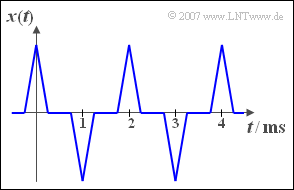Difference between revisions of "Aufgaben:Exercise 2.1: Rectification"
From LNTwww
| (35 intermediate revisions by 5 users not shown) | |||
| Line 1: | Line 1: | ||
| − | {{quiz-Header|Buchseite= | + | {{quiz-Header|Buchseite=Signal Representation/General Description |
}} | }} | ||
| − | [[File:P_ID239__Sig_A_2_1.png|250px|right| | + | [[File:P_ID239__Sig_A_2_1.png|250px|right|frame|Periodic triangular signal]] |
| − | + | The graph shows the periodic signal $x(t)$. If $x(t)$ is applied to the input of a non-linearity with the characteristic curve | |
| − | $$y=g(x)=\left\{ {x \; \rm | + | :$$y=g(x)=\left\{ {x \; \rm for\; \it x \geq \rm 0, \atop {\rm 0 \;\;\; \rm else,}}\right.$$ |
| − | + | the signal $y(t)$ is obtained at the output. A second non-linear characteristic | |
| − | $$z=h(x)=|x|$$ | + | :$$z=h(x)=|x|$$ |
| − | + | delivers the signal $z(t)$. | |
| − | === | + | |
| + | |||
| + | |||
| + | |||
| + | |||
| + | |||
| + | ''Note:'' | ||
| + | *This exercise belongs to the chapter [[Signal_Representation/General_Description|General description of periodic signals]]. | ||
| + | |||
| + | |||
| + | |||
| + | |||
| + | ===Questions=== | ||
<quiz display=simple> | <quiz display=simple> | ||
| − | { | + | {Which of the following statements are true? |
|type="[]"} | |type="[]"} | ||
| − | +$y = g(x)$ | + | +$y = g(x)$ describes a half-wave rectifier. |
| − | -$y = g(x)$ | + | -$y = g(x)$ describes a full-wave rectifier. |
| − | -$z = h(x)$ | + | -$z = h(x)$ describes a half-wave rectifier. |
| − | +$z = h(x)$ | + | +$z = h(x)$ describes a full-wave rectifier. |
| − | { | + | {What is the base frequency $f_0$ of the signal $x(t)$? |
|type="{}"} | |type="{}"} | ||
| − | $f_0$ | + | $f_0 \ = \ $ { 500 3% } $\text{Hz}$ |
| − | { | + | {What is the period duration $T_0$ of the signal $y(t)$? |
|type="{}"} | |type="{}"} | ||
| − | $T_0$ | + | $T_0 \ = \ $ { 2 3% } $\text{ms}$ |
| − | { | + | {What is the basic circular frequency $\omega_0$ of the signal $z(t)$? |
|type="{}"} | |type="{}"} | ||
| − | $\omega_0$ | + | $\omega_0 \ = \ $ { 6283 3% } $\text{1/s}$ |
</quiz> | </quiz> | ||
| − | === | + | ===Solution=== |
{{ML-Kopf}} | {{ML-Kopf}} | ||
| − | '''1 | + | '''(1)''' Correct are the <u>solutions 1 and 4</u>: |
| + | *The non-linear characteristic $y = g(x)$ describes a half-wave rectifier. | ||
| + | *$z = h(x) = |x|$ describes a full-wave rectifier. | ||
| + | |||
| + | |||
| + | '''(2)''' The period duration $x(t)$ is $T_0 = 2\,\text{ms}$. The inverse magnitudes to the base frequency $f_0 \hspace{0.1cm}\underline{ = 500\,\text{Hz}}$. | ||
| + | |||
| − | ''' | + | '''(3)''' The half-wave rectification does not change the duration of the period, see the left graph: $T_0 \hspace{0.1cm}\underline{= 2\,\text{ms}}$. |
| − | + | [[File:P_ID262__Sig_A_2_1_a.png|center|frame|Periodic triangular signals]] | |
| − | [[File: | ||
| − | '''4 | + | '''(4)''' After full-wave rectification, the signal $z(t)$ has double the frequency (see right graph). The following values apply here: |
| + | :$$T_0 = 1\,\text{ms}, \hspace{0.5cm} f_0 = 1\,\text{kHz}, \hspace{0.5cm} \omega_0 \hspace{0.1cm}\underline{= 6283\,\text{1/s}}.$$ | ||
{{ML-Fuß}} | {{ML-Fuß}} | ||
__NOEDITSECTION__ | __NOEDITSECTION__ | ||
| − | [[Category: | + | [[Category:Signal Representation: Exercises|^2.1 Description of Periodic Signals^]] |
Latest revision as of 05:08, 18 September 2022
The graph shows the periodic signal $x(t)$. If $x(t)$ is applied to the input of a non-linearity with the characteristic curve
- $$y=g(x)=\left\{ {x \; \rm for\; \it x \geq \rm 0, \atop {\rm 0 \;\;\; \rm else,}}\right.$$
the signal $y(t)$ is obtained at the output. A second non-linear characteristic
- $$z=h(x)=|x|$$
delivers the signal $z(t)$.
Note:
- This exercise belongs to the chapter General description of periodic signals.
Questions
Solution
(1) Correct are the solutions 1 and 4:
- The non-linear characteristic $y = g(x)$ describes a half-wave rectifier.
- $z = h(x) = |x|$ describes a full-wave rectifier.
(2) The period duration $x(t)$ is $T_0 = 2\,\text{ms}$. The inverse magnitudes to the base frequency $f_0 \hspace{0.1cm}\underline{ = 500\,\text{Hz}}$.
(3) The half-wave rectification does not change the duration of the period, see the left graph: $T_0 \hspace{0.1cm}\underline{= 2\,\text{ms}}$.
(4) After full-wave rectification, the signal $z(t)$ has double the frequency (see right graph). The following values apply here:
- $$T_0 = 1\,\text{ms}, \hspace{0.5cm} f_0 = 1\,\text{kHz}, \hspace{0.5cm} \omega_0 \hspace{0.1cm}\underline{= 6283\,\text{1/s}}.$$

